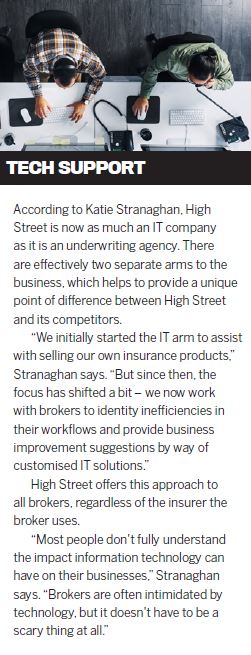

As professional indemnity insurance expands into new markets, IB caught up with Katie Stranaghan of High Street Underwriting Agency to find how the changes will affect brokers and insurers alike
Joining High Street Underwriting Agency virtually straight out of high school, Katie Stranaghan has already made an impressive mark in the highly competitive world of professional indemnity. As the field continues to grow in importance across a wider variety of industries, Stranaghan is eager to see brokers become a greater part of the conversation around the whole process, from initial consultation through to claims.
“As we move into a harder market, the broker’s understanding of their client is particularly crucial,” she says. “Simple things like managing the client’s expectations on foreseeable changes on rates and appetite or making sure renewal submissions are submitted in good time can make a huge difference to the process of placing cover.”
In general, PI is evolving away from traditional professions such as accountants and lawyers and into many new areas. Many of High Street’s risks are written in the mining, architectural and engineering spaces, but there are still surprises that pop up from time to time, and Stranaghan prides herself on her ability to rise to the challenge of more niche requests.
“I recently quoted for a sculptor who primarily designs large art displays made from bamboo and other eco-friendly materials,” she says.
Quotes for niche specialists like this are indicative of the new norm within PI. While insurers and brokers typically have a good understanding of their professional duty within traditional areas, these new frontiers are often presenting challenges. Now that consumer perception has taken on an everincreasing importance in the age of social media, many businesses are eager to protect their reputation if something does go wrong, alongside the simple safety aspects that come in to play with any workplace.
“More and more businesses outside of the traditional PI arena are being asked in contracts to carry PI cover,” Stranaghan says. “There’s often a less clear-cut understanding around the exposures these businesses and contractors face.”
It’s a situation that cuts across the business, broker and insurer, Stranaghan notes. Businesses new to professional indemnity don’t always know what they need, and brokers unfamiliar with the specifics of the industry won’t necessarily pick up on everything they should be covering. Similarly, insurers can’t write an effective policy or assess risk appropriately if they lack the relevant knowledge.
As an industry heavily reliant on precedent and data, insurers are facing new challenges where neither precedent nor data exist. Accordingly, all the parties involved need to work together, particularly as professional indemnity gains an increased importance among a broader variety of industries, Stranaghan says.
“Brokers who assist clients by fully understanding their risk exposures can assist with advocacy and guidance on managing those risks, ultimately achieving better terms,” she says. “Additionally, as insurers revise appetites, it’s crucial that brokers have a full knowledge and strong relationships with the insurers in that sector.”
 “More and more businesses outside of the traditional PI arena are being asked … to carry PI cover. There’s often a less clear-cut understanding around the exposures these businesses and contractors face” Katie Stranaghan, High Street Underwriting Agency
“More and more businesses outside of the traditional PI arena are being asked … to carry PI cover. There’s often a less clear-cut understanding around the exposures these businesses and contractors face” Katie Stranaghan, High Street Underwriting AgencyThe changing face of the workforce
Change within the industry isn’t solely limited to an increase in the businesses that are now participating in PI. The insurance workforce itself is undergoing a shift as gender diversity grows. Insurance has traditionally been perceived as a male-dominated industry, but women like Stranaghan are beginning to change that perception – both from within and outside the field.
Within High Street, Stranaghan says she has the full support of the management team and describes herself as lucky to have been given particular career opportunities. Her rapid ascent in the company over the last few years is evidence that she’s worked to make these opportunities her own, too.
“I’m not sure how people perceive me initially, due to being a young woman in a male-oriented industry – but to be honest, I don’t give it a great deal of thought, which I find is the best way,” she says. “Hopefully once people realise that I know what I’m talking about, not much else matters.”
Stranaghan also sees herself as a reflection of a wider trend within the industry, where women are increasingly being encouraged to pursue insurance as a professional career beyond just administrative roles.
“I think the shift has already begun in the industry, and gender diversity is becoming more and more the norm,” she says.
She points to initiatives like Women in Insurance conferences, where successful female speakers provide examples of their own experience in the industry and the heights that can be reached with the right tools at your disposal.
“They reaffirm that it’s possible to break through the glass ceiling,” Stranaghan says. “It serves an inspiration for what can be achieved within the field.”
The road ahead
Given the changes that are taking place across professional indemnity insurance, there is much speculation about what the future holds. Perhaps the most obvious prediction is that PI is likely to continue to increase in importance. Businesses are understandably becoming more risk-averse and are looking for protection for both their cash flow and their reputation.
Yet it’s not quite that simple, as Stranaghan points out. There has been an overall hardening of the market, to the extent that some risk-bearers – like Certifiers – have been struggling to source cover at all. It’s been a massive shift, Stranaghan says, and one that reverses the trend of falling rates that has been consistent since 2004.
“We didn’t really anticipate the rapid changes in the PI space over the last 12 months,” she says. “It’s difficult to know with certainty which way the market will turn – we’ve seen certain professions hit harder than others, but as rates rise, it’s quite possible that more insurers will return to the market.”
Stranaghan stresses that it’s important to remember that the market has been soft for more than a decade. Accordingly, most of the low-risk professions remain attractive to insurers. “We may see a two-speed market with miscellaneous risks remaining competitively priced and others hardening further still,” she says.
Despite the changes ahead, Stranaghan remains confident that High Street will be equipped to handle them.
“We’ve built our reputation on being an insurer that can handle unique situations and bespoke policies,” she says. “The market goes in cycles and shifts, but that’s not something that’s going to change for us – if anything, that’s a skill that’s going to become even more important in future years.”
